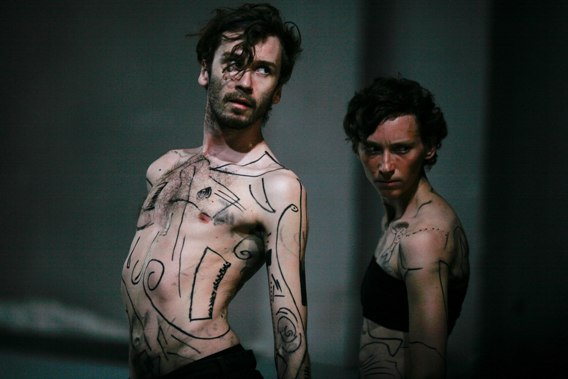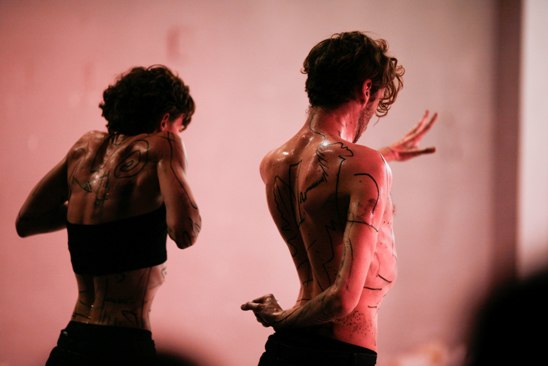Tremendous Transformations of Tereza Ondrová and Peter Šavel
 The dance project called Boys who like to play with dolls, created by Tereza Ondrová and Pavel Šavel, featured at the Malá Inventura 2012 festival of new theatre after a several-month pause. Since its premiere, the piece has only been performed twice in the Czech republic but in the meantime, it has gained attention of experts abroad and was listed among the top ten dance projects by the all-European dance platform Aerowaves.
Tereza Ondrová and Peter Šavel, both brilliant dancers and outstanding performers, had already worked together on an equally successful project called Much More Than Nothing, produced by the ME-SA company. This collaboration, marked by mutual ideational and artistic understanding, resulted in a creation of a duet dealing with gender issues. It plays with socially determined roles and the performers relativize them, switch them, cross their limits…
The dance project called Boys who like to play with dolls, created by Tereza Ondrová and Pavel Šavel, featured at the Malá Inventura 2012 festival of new theatre after a several-month pause. Since its premiere, the piece has only been performed twice in the Czech republic but in the meantime, it has gained attention of experts abroad and was listed among the top ten dance projects by the all-European dance platform Aerowaves.
Tereza Ondrová and Peter Šavel, both brilliant dancers and outstanding performers, had already worked together on an equally successful project called Much More Than Nothing, produced by the ME-SA company. This collaboration, marked by mutual ideational and artistic understanding, resulted in a creation of a duet dealing with gender issues. It plays with socially determined roles and the performers relativize them, switch them, cross their limits…At the beginning of the performance, the two dancers are sitting on chairs, trying to find a comfortable yet eye-appealing position. They are wearing the same jeans, identical hairdos and strange body paintings which might represent the social rules that shape their lives. They pronounce the rules aloud, too; Tereza Ondrová in Czech and Peter Šavel in English. The performers impart to themselves the way they should look like and the impression they should give – according to their sex. But in the very next moment they stand up and set off for a journey - for a real journey across the stage and for a metaphorical journey which makes all the set rules disappear. The dancers’ energetic, perfectly synchronized and initially “genderless” walk gives way to catwalk that may define the masculine and the feminine roles which blend together just a few moments later. Peter imitates Tereza’s hip rolling and suddenly seems very feminine, Tereza, on the contrary, becomes rough and masculine. The role-switching accelerates and the skilfully performed moves and gripping expressionism make the audience laugh and sigh with admiration. The physical transformations of both performers are truly elaborate as they are able to change their stage personality and role just by a slight alteration in the posture or hip movement.
 In the second half of the show, the dancers reach a sort of higher, “supra-gender” level. They become animal-like creatures, moving in their own specific way. The shapes of their bodies are deforming, they are twisting into awkward positions, as if overcome by spasms and impulses. They are freeing their bodies from all the rules which, under the physical effort, are slowly being washed out of their skin. After this interesting, though a little lengthy part, the performance culminates in a surprising finale when the dancers start to imitate one of the pieces forming the musical accompaniment of the choreography. They vocalise themselves some beautiful sacral music, originally sung by a women’s choir – and they manage to do it very well, facing bravely the tricky high-pitched tones and intricate embellishments. Even during this charming moment the performers still kept it funny and they put their singing down by mimicking some great suffering. The final scene, at once meditative and grotesque, made a poignant résumé of the entire piece in which its creators had been skilfully balancing on the edge between the comic and the serious.
The most fascinating aspect of the performance was the dancers’ perfect synchrony, from the casual walk to the surprising vocal duet at the end. Their movements were in such a perfect unison that after a while it was almost impossible to distinguish between the female and the male dancer, between a woman and a man. Their physicality was the main means of expression and it was incredibly suggestive. The authors had spotted and then demonstrated - in a deliberately exaggerated way – the typical masculine and feminine move patterns only to decompose them completely and to come up with their proper body language. In the course of that physical exploration, the two bodies were undergoing a transformation, not in the least painless but liberating. The performance did not offer just exquisite dancing but also an interesting possibility of looking at gender issues through the original expressive forms of contemporary dance.
Writtent from the performance on 21st February 2014, Studio Alta.
Boys Who Like to Play With Dolls
In the second half of the show, the dancers reach a sort of higher, “supra-gender” level. They become animal-like creatures, moving in their own specific way. The shapes of their bodies are deforming, they are twisting into awkward positions, as if overcome by spasms and impulses. They are freeing their bodies from all the rules which, under the physical effort, are slowly being washed out of their skin. After this interesting, though a little lengthy part, the performance culminates in a surprising finale when the dancers start to imitate one of the pieces forming the musical accompaniment of the choreography. They vocalise themselves some beautiful sacral music, originally sung by a women’s choir – and they manage to do it very well, facing bravely the tricky high-pitched tones and intricate embellishments. Even during this charming moment the performers still kept it funny and they put their singing down by mimicking some great suffering. The final scene, at once meditative and grotesque, made a poignant résumé of the entire piece in which its creators had been skilfully balancing on the edge between the comic and the serious.
The most fascinating aspect of the performance was the dancers’ perfect synchrony, from the casual walk to the surprising vocal duet at the end. Their movements were in such a perfect unison that after a while it was almost impossible to distinguish between the female and the male dancer, between a woman and a man. Their physicality was the main means of expression and it was incredibly suggestive. The authors had spotted and then demonstrated - in a deliberately exaggerated way – the typical masculine and feminine move patterns only to decompose them completely and to come up with their proper body language. In the course of that physical exploration, the two bodies were undergoing a transformation, not in the least painless but liberating. The performance did not offer just exquisite dancing but also an interesting possibility of looking at gender issues through the original expressive forms of contemporary dance.
Writtent from the performance on 21st February 2014, Studio Alta.
Boys Who Like to Play With DollsConcept, choreography and dance: Tereza Ondrová, Peter Šavel
Light design: Jiří Hajdyla
Premiere: 17. 5. 2013 Photo by: Antonín Matějovský


